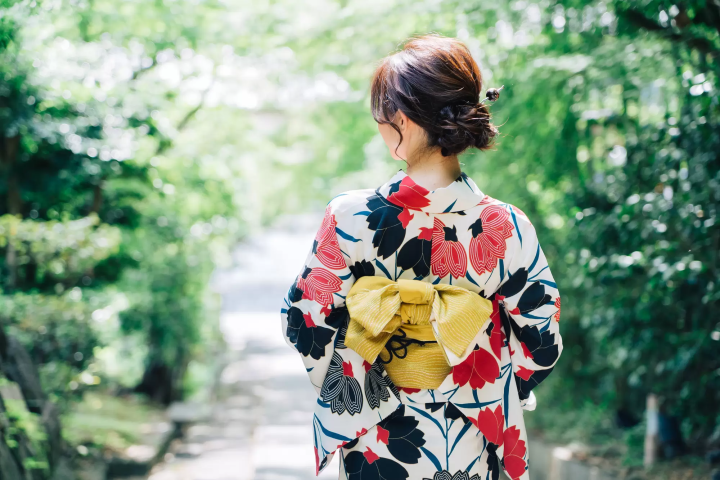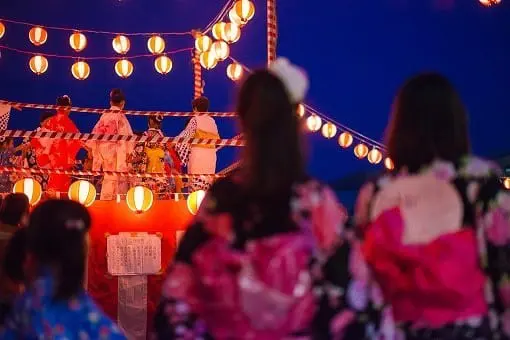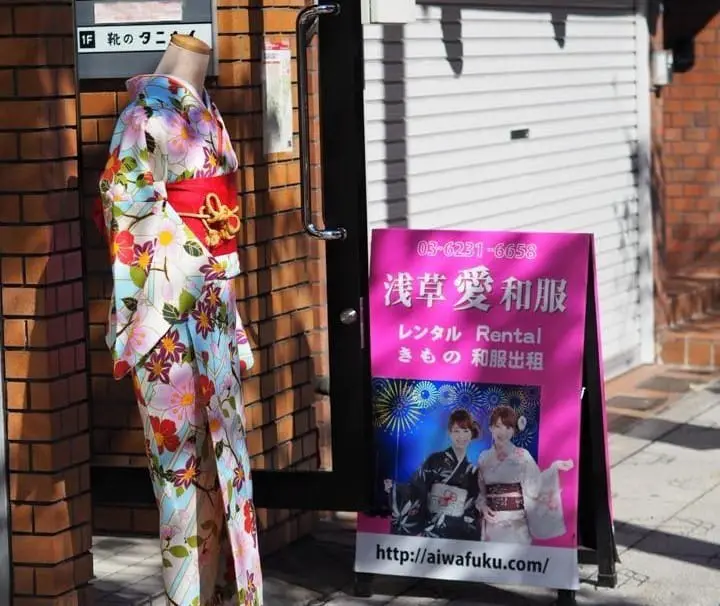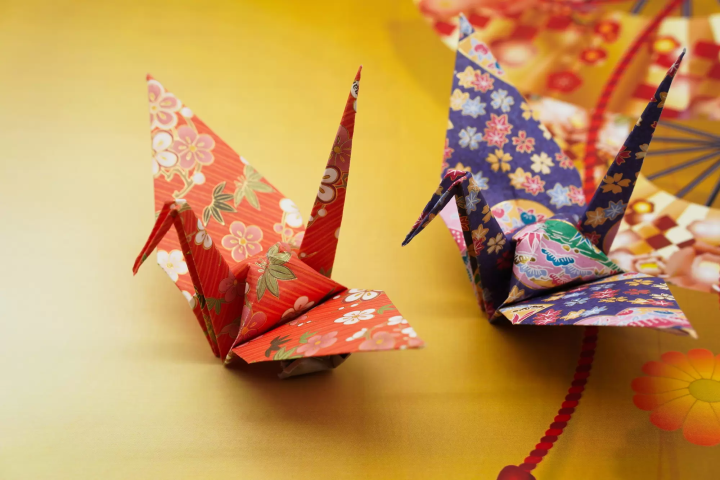All About Yukata: The Traditional Japanese Summer Kimono

The yukata is a lighter summer kimono. This article explains how to put on a yukata with a video, when to wear it, how it differs from traditional kimono, and the kinds of yukata styles. Learn more about how you can appreciate and wear this traditional Japanese garment yourself!
Yukata: Light Summer Kimonos
1. What Is a Yukata?
2. How Is the Yukata Different from a Kimono?
3. When to Wear Yukata
4. How to Put On a Yukata
5. Renting a Yukata at Kimono Rental Shops
6. Tips When Wearing Yukata
7. Yukata Styles
8. Enjoy Wearing Japanese Yukata!
What Is a Yukata?
Yukata are a type of traditional Japanese clothing. It is most commonly worn in the summer, but they are also often offered to guests who stay in a ryokan (a Japanese inn, typically with tatami mat rooms and onsen, serving Japanese cuisine and offering other uniquely Japanese experiences).
When a place of accommodation offers yukata to guests, they can be worn anywhere; when sleeping at night, when traveling from your room to the hot springs, and even for strolling around town.

Photo by Pixta
The yukata originated as a type of bathrobe worn by the aristocrats of the Heian period (794-1185) and later became popular among the general public during the Edo period (1603-1868). Over time, it evolved into a garment worn for leisure activities and social gatherings, especially during hot summer days.
The design of a yukata usually features colorful patterns, often with seasonal motifs such as flowers, fireworks, or traditional Japanese symbols. It is typically worn with a sash called an obi, which is tied around the waist to secure the garment in place.
How Is the Yukata Different from a Kimono?

Traditional Japanese Kimono paired with a wagasa umbrella
Oftentimes, people mistake a yukata for a kimono when they see one. While there are similarities between the two, they are fundamentally two different types of clothes.

Wearing a Japanese yukata
First of all, the fabric used is completely different. Kimono are made from silk, whereas yukata are generally made with cotton or other light and breathable textiles. Yukata are worn generally in the summer season for this reason. On the other hand, a kimono consists of more layers, and is much more thick and heavier than a yukata.
Yukata are traditionally considered to be informal attire rather than formal wear. It is typically worn for casual outings, summer festivals (matsuri), fireworks displays, or relaxing at home. While Yukata can be elegantly designed and visually striking, it is generally not appropriate to wear them to formal parties or events that require formal attire.
For formal occasions in Japan, such as weddings, tea ceremonies, or other ceremonies, individuals typically wear formal kimono, which are more intricate in design and require specific accessories and styling. These formal kimono feature elaborate patterns and embroidery, and they are worn with corresponding accessories like obi belts, obijime cords, and with elaborate hairstyles.
Along with yukata having a more of a casual style, they are far more affordable than kimono are. Therefore, it is much easier for people to purchase one and wear one around on a more regular basis.
When to Wear Yukata

Yukata are most popular during the summer months, where the unlined cotton fabric is most suited to combat the hot temperature. They can be worn around everyday; however, it is most common to see young people wearing them during firework festivals, called hanabi taikai in Japanese.
At these firework festivals, both girls and guys wear their favorite yukata to watch the stunning nighttime displays. Yukata can also be worn at summer matsuri (festivals), specifically the traditional Buddhist bon-odori festival which honors one's ancestors.
Yukata are offered to guests year round at Japanese ryokan. Ryokan are accommodations that usually have onsen, Japanese hot spring baths, and in these occasions, yukata can be worn regardless of the season. Even in the cold winter months, these yukata are worn when traveling from the your ryokan room to the onsen.
How to Put On a Yukata
At first, wearing any type of traditional Japanese style clothing, like yukata, can seem intimidating. However, the process is actually much simpler than you would think. First, begin by putting the yukata on as if it's a robe, tucking the right side of the yukata underneath the left. The left side should be covering the right and pulled over to the side of the body.
Proper Dressing: When putting on a Yukata, it's essential to follow the proper dressing etiquette. Ensure that the left side crosses over the right side when tying the garment, as the reverse is traditionally reserved for dressing the deceased.
After the first step, place the obi (sash) around the middle of your waist so that the sash is touching the front of the yukata but not the back. Then, wrap the obi around yourself, crossing your back once, with the two ends of the obi back towards the front of your body. Tie the sash into a bow at the front and then move the knot slightly off-center of your body.
Obi Tying: Tying the obi correctly is important for both comfort and aesthetics. While there are various methods for tying the obi, it's recommended to ask for assistance from staff or refer to online tutorials if needed.
Footwear: When wearing Yukata, it's customary to pair them with geta (wooden sandals) or zori (traditional sandals) rather than regular shoes. These can often be rented or purchased along with the Yukata.
Renting a Yukata at Kimono Rental Shops

Yukata Rental Shops
In Japan, you can use the services of kimono rental shops to borrow a yukata or a kimono for a day. Licensed kimono professionals will dress you up and, at most of the shops, you can even have your photo taken!
In Tokyo, we recommend the services of VASARA in Asakusa. You can choose between their Yukata Standard Plan for 3,300 yen (tax not included) or Yukata Retro Plan for 6,500 yen (tax not included).
Asakusa is a traditional neighborhood famous for the Sensoji Temple and the Sumida River and is an ideal place to wear yukata and take pictures. The cherry blossom season in spring brings sakura trees blooming alongside the river, which make for some lovely photos.
If you visit Kyoto, you can wear a yukata and have your picture taken against the background of beautiful temples. We suggest looking into local kimono rental shop Yumeyakata in the Gion area. Gion is the old geisha district in Kyoto and has a traditional townscape complete with shrines and temples. Arashiyama is also famous for its sakura and red and gold foliage in the fall, with many rental shops in the area.
Read also
Tips When Wearing Yukata
Whether you are buying a yukata for yourself or just renting it for a day, keep in mind the following tips.
Respecting Cultural Norms: While wearing Yukata, it's essential to be respectful of Japanese cultural norms. Try to avoid inappropriate behavior, such as excessive noise or public displays of affection, especially in more traditional areas or during cultural events.
Care and Maintenance: Yukata are delicate garments, so it's important to take care when wearing and handling them. Avoid dragging the hem on the ground, and be mindful of stains or spills. If renting, strive to return the Yukata in the same condition it was received.
Yukata Styles

The style of yukata is much more relaxed than that of kimono. Generally, there are more whimsical options and brighter colors offered for purchase. Although yukata were initially made with indigo dyed cotton, making them mostly a deep blueish color, in modern times there is much more freedom with their designs.
Generally, younger women and children wear more lively patterns, while older women wear more subdued styles. Men’s yukata generally come in darker colors and are often plain without patterns.
Enjoy Wearing Japanese Yukata!
During the hot Japanese summer months, a yukata is a must-have item in order to fashionably combat the heat. An iconic Japanese outfit, the yukata stands out with their light fabric and whimsical designs.
More affordable than a silken kimono, which can cost upwards of a thousand dollars, the price range for yukata makes it a perfect gift to buy - either for yourself or as a souvenir for someone else. This summer season, enjoy the weather the right way - by wearing yukata!
This account is managed by MATCHA. We aim to provide useful information to our readers in an enjoyable manner.







































![[2026] Top 5 Strawberry Picking Spots in Tokushima, Naruto| Farms and Access Guide for January to May](https://resources.matcha-jp.com/resize/720x2000/2025/03/06-227165.webp)



